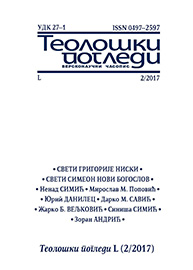Примери променљивости личног имена Срба православаца у црквеним матичним књигама Темишвара XVIII и XIX века
The Examples of Orthodox Serbs’ Personal Name Changing in XVIII and XIX Centuries Timişoara Church Birth/Marriage/Death Registries
Author(s): Žarko B. VeljkovićSubject(s): History of Church(es), 18th Century, 19th Century, Eastern Orthodoxy
Published by: Свети Архијерејски Синод
Summary/Abstract: Researching my maternal ancestors in XVIII and XIX centuries church birth/marriage/ death registries of two oldest Serbian churches in Timişoara, I discovered an interesting language phenomenon. Namely, in those old church birth/marriage/ death registries certain number of persons is inscribed not just by his endearing (hypocoristic) name or shortened name (kurzname), but by completely other, so called secondary name, and some persons had double name or more names. Here I present the exemples which I’ve found. From those exemples the following models and submodels of personal name change in XVIII and XIX centuries Timişoara can be defined: 1) During lifetime, a person obtained one more name, e. g. Aron became Dimitrije Aron, which includes the situation when a person changed his faith, having thus two names, the old and new one, e. g. Avgustina Marija. 2) In christening, a person was given double name, e. g. Dimitrije-Georgije. 3) The name itself shortened from the end to shortened name (kurzname), homonymic to some other (full) name, e. g. Živana is shortened to Ana. 4) The name itself was transformed to its endearing (hypocoristic) name, e. g. Jeftimije became Jefta, and 5) The name itself through shortened name (kurzname) or its endearing (hypocoristic) namewas transformed to some other endearing (hypocoristic) name, e. g. Živana, obtained in christening, was shortened to Ana, and later transformed to Stana and Nasta. The conclusion is that in XVIII and XIX centuries Timişoara personal name wasn’t obligatory singular, nor unchangeable phenomenon, i. e. a person could be born with one name, and die with other name added, with other name or names, with shortened name or names (kurzname(n)), with endearing (hypocoristic) name or names or, on the other side, be born with double name. I think that this orthodox Serbs’ personal name doubling (whatever’s the maner it’s been done) should be attributed to linguistic influence of double name formula of Germans and Hungarians, which influnced the Romanian as well, thus in Romanian there’s phenomenon that a person can have double name. Though, it’s possible that this orthodox Serbs’ personal name doubling is connected with apotropaic function of protecting new-born from death.
Journal: Теолошки погледи
- Issue Year: L/2017
- Issue No: 2
- Page Range: 317-334
- Page Count: 18
- Language: Serbian

